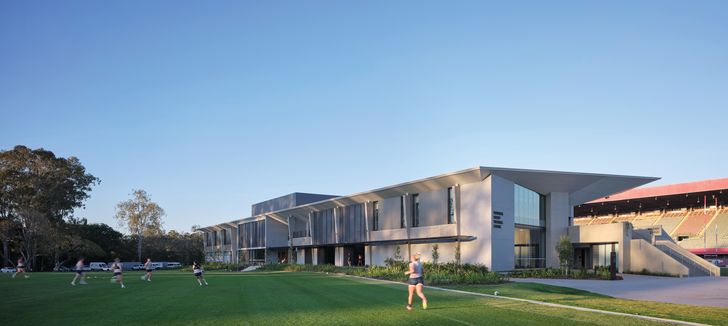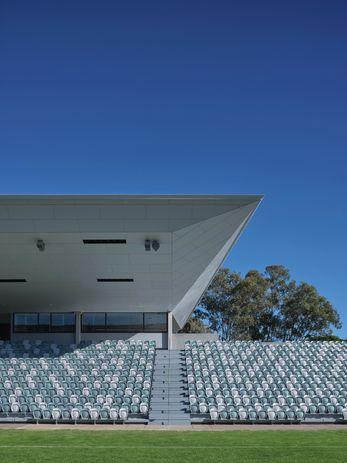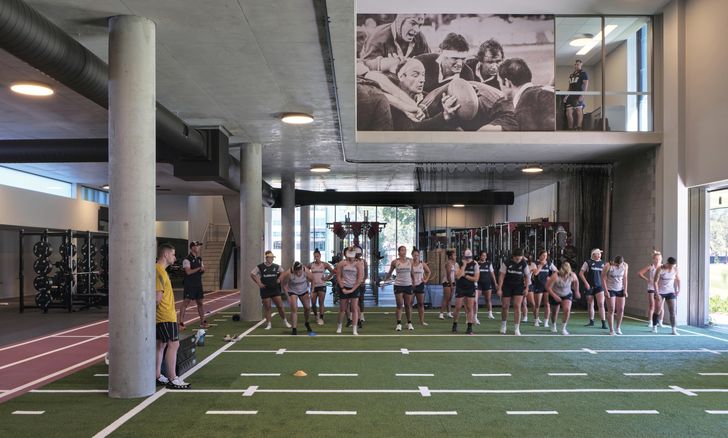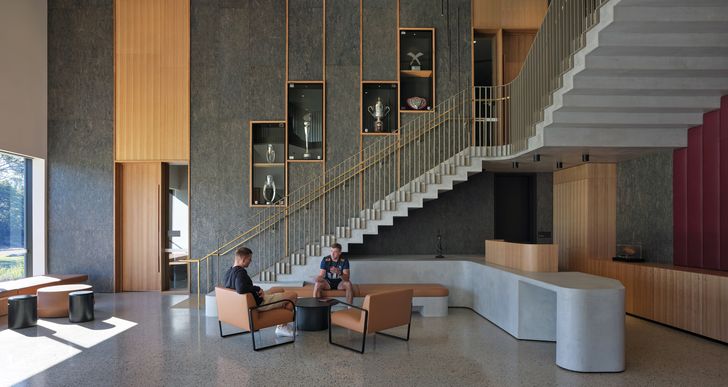National Rugby Training Centre, Ballymore by Blight Rayner ...
For many rugby devotees, Brisbane’s Ballymore Stadium was the indomitable heart of Queensland Rugby Union (QRU) until 2006, when the Queensland Reds transferred their home games to the Lang Park stadium at Milton, the traditional home of the competing format of Rugby League. The change enabled far larger crowds, but many felt that it also led to a loss of sporting camaraderie and a weakening of Ballymore’s invigorating community spirit.

In the wake of the transfer, Ballymore continued to serve as a subsidiary training and administration satellite within its parkland precinct, bordered by Enoggera Creek, in the inner suburb of Herston. Over time, and despite its bucolic environment, the stadium and its ancillary buildings began to suffer from neglect, and the attraction and value of the venue withered. Ultimately, of the four stands that once constituted the main stadium, only the original grassed southern stand – “the Hill” – has been retained. The temporary northern stand fell into disrepair and was demolished, while the eastern stand was taken out of action to await either renovation or demolition. The fourth stand, the original McLean stand, was demolished and its site allocated for a new stand for the National Rugby Training Centre (NRTC).
By replicating the scale of the old stand in the new, Blight Rayner sought to tap into a sense of nostalgia for the much-loved original Ballymore Stadium
Image: Christopher Frederick Jones
QRU held a design competition for the NRTC in 2020. The awarding of the project to Blight Rayner was a dream come true for practice director Michael Rayner, a longstanding rugby “tragic” and Ballymore supporter. The brief emphasised the need for the design to encourage interaction between the various users of the centre, which is the headquarters of the Wallaroos (Australia’s women’s national Rugby Union team) and the training ground for the Queensland Reds men’s, women’s and academy teams. Further, the design was charged with fostering a strong sense of community and of enabling the centre’s various elements, facilities and training equipment to be shared.
The allocation of federal and state government funding, which provided substantial impetus for the project, relied on the integration of women’s sports as well as the opportunity for local clubs and school teams to train at the facility under the supervision of Reds coaches. With rugby participation dwindling across Australia, and Rugby Australia encouraging the states to strengthen the “grassroots” rugby community, the centre would also provide vital facilities for regional and community teams.

As well as being the home of the Wallaroos and the training ground for the Queensland Reds, the NRTC is the national centre for women’s rectangular sport and will be the hockey venue for the 2032 Olympic and Paralympic Games.
Image: Christopher Frederick Jones
Opened in mid-2023, the new 3,010-seat McLean grand-stand and NRTC combined has set a new benchmark for a national sports project: while responding to the brief, it has also enhanced and re-energised a fading community resource. Rayner says that “although the NRTC was built primarily for the elite teams, it is more and more being seen as the fulcrum for improving community wellbeing across the state through sport.”
The design and principal planning of the project was governed by the size, scale and linearity of the new, east-facing grandstand, which stretches along the length of the rugby field. Grandstand access is from the southern forecourt via stairs (or lift) to a generous concourse that, together with the raked bank of seats, is sheltered and shaded by the striking chamfered plane of the cantilevered roof. “Our idea,” explains Rayner, “was to create a building not iconic but replete in its setting of playing fields and parklands. It also occurred to us that if we could replicate the scale of the old McLean Stand – and, to an extent, its form – we might be able to tap into a nostalgia for the past halcyon days of Ballymore.”
The west-facing facilities nestle against the grandstand’s spine. To minimise flood risk, the ground floor sits a metre above the adjacent training pitch. The two-storey volume of the reception is both welcoming and impressive thanks to its scale and the quality of its finishes. The reception and the adjacent auditorium look both outwards, to the training field, and inwards, offering glimpses through to active internal spaces and to the level above.

A generous indoor skills activation area and adjacent high-performance gymnasium are shared by men’s and women’s teams.
Image: Christopher Frederick Jones
Also on the ground floor is the high-performance gymnasium, which is used by both men’s and women’s teams for training and exercising. Part of the gymnasium space is double-height to provide a “pre-activation” area that accommodates lineout and kicking practice. The volumetric connection also enables coaching staff to oversee their teams in training from their workspace on the upper level. The generosity of the space is amplified by sliding window walls that allow this heavily used area to be opened to the elements. Physiotherapy, rehabilitation and doctors’ consultation rooms are all accessible from the gymnasium.
The Reds men’s locker room doubles as a players’ social hub. “The players told us this is the place where they most hang out, rather than the gym or players’ lounge upstairs, so we made it feel more like a softly lit living room,” comments Rayner. The space receives daylight from the concourse above, through clerestory windows. Connected to the locker room are the players’ change amenities, which link to a sauna, hot and cold plunge pools and a resistance pool. These facilities are also accessible from the main hallway so that other teams can use them when they’re available.
Larger-than-life shots of past and present Reds and Wallaroos players in action, including a trio of Reds Indigenous women players, energise the ground-floor hallway and other key spaces. The images were jointly selected by the QRU Heritage Committee, the QRU Executive and Rayner and curated with the assistance of Brisbane-based architect Andrew Uttley, who is also helping Blight Rayner with the selection and curation of memorabilia for a hall of fame.

The “surprisingly delicate” stairway from the reception leads to administration areas and the players’ lounge on the upper level.
Image: Christopher Frederick Jones
Trophy cases are built into the panelling that flanks the surprisingly delicate stairway to the upper level, where the offices of the Reds coaches and the QRU administration area all have views to the main rugby field. Meeting rooms and the boardroom, which also overlook the field, can be employed as grandstand suites. A multifunction space for match days and corporate events serves a dual purpose as the Reds players’ lounge.
Resoundingly, the design of the NRTC has met the ambitions defined in the initial brief. The quality of the spaces, the coherent spatial relationship established between each of the principal administrative bodies and rugby agencies, and the expressive form of the building envelope all serve to restore Ballymore as a first-class home for rugby at state and national levels. The external architecture is “relatively simple and unprepos-sessing, intended to impart belonging to the wider community and to clubs as much as to elite teams,” notes Blight Rayner.
As well as being the national centre for women’s rectangular sport (rugby, Rugby League and football), the stadium has been declared the hockey venue for the 2032 Olympic and Paralympic Games in Brisbane. Duly, Blight Rayner has prepared a masterplan that builds on the success of the NRTC and reinforces the local benefits that could flow from the Olympics. The proposals include renovating the eastern stand, establishing a sports training facility adjacent to the Hill, and strengthening community recreation through additional open plazas and interlinked green spaces. More ambitious still is the idea for two bridges across the Enoggera Creek from the nearby Finsbury and Langley Avenue parks, enabling sporting activities to be consolidated. These linkages would also create further opportunities for the community to enjoy the natural qualities of Enoggera Creek and Ballymore Park as an active legacy of the Olympics.







































































